Meet The Right Breed of Dog For You
Kim Brophey, Meet Your Dog
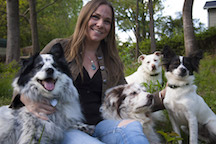 Don't just get a dog because it's cute. To ensure a long lasting relationship, you should get a breed that suits your activity level, as some dogs require lots of stimulation while others, like the unsuspecting Greyhound, would rather be a couch potato. Behaviorist Kim Brophey is here to help you pick out your new furry family member with tips in her brand new book called, "Meet Your Dog," where she explains what you should be looking for in a new dog.
Don't just get a dog because it's cute. To ensure a long lasting relationship, you should get a breed that suits your activity level, as some dogs require lots of stimulation while others, like the unsuspecting Greyhound, would rather be a couch potato. Behaviorist Kim Brophey is here to help you pick out your new furry family member with tips in her brand new book called, "Meet Your Dog," where she explains what you should be looking for in a new dog.
One of the things Kim hopes is very helpful about her new book is that it really gets people in the mindset of looking at the whole picture. You might think it's all how you raise them. They're just a pet. If we do everything right with a dog and given them what they need, then everything should be just dandy. However, the reality is we all have really different environments and lifestyles. A dog is going to come into that environment and lifestyle with everything from their past experiences that they've had before they were with us, at their particular age, sex, health development, etc. and the genetics that they were born with. All of these factors can either work really well within our lifestyle conditions and relationships, or we can have a little bit of friction.
Many times people have a childhood love of a certain breed and as an adult they decide they would like to get another one. However, they're not in the right living situation for that breed. They've already made their decision, get the dog, and now have to deal with the after effects of that.
Kim tells us that once somebody has already made up their mind and followed through and gotten what might be the wrong dog for their current situation, she feels like the role that we should be trying to play, at least for the professionals, is mediating or a good healthy reality check. She doesn't think it does anyone any service to pretend that some of those pressures aren't going to be there. So she'll tell people what this animal was originally bred to do. Our ancestors painstakingly developed these kinds of behaviors. So what's not fair is to simply project motive onto the dog and call those behaviors that they were born with out of their own control, bad and then punish them.
 She tries to help people understand that there is sometimes genetic software and motor patterns that need to be appropriately developed in a certain manner. So for herding dog, for instance, you can create daily games and rituals that satisfy their need to be organizers and intense micro-managers. You can teach them to herd large balls in your backyard and put them away in kid's soccer nets. Things that we would think would be kind of ridiculous might satisfy those genetic urges. So she tries to help them find appropriate ways to do that. She also tells them to be more compassionate when the dog is engaging in ways that they're not necessarily deliberately intending to.
She tries to help people understand that there is sometimes genetic software and motor patterns that need to be appropriately developed in a certain manner. So for herding dog, for instance, you can create daily games and rituals that satisfy their need to be organizers and intense micro-managers. You can teach them to herd large balls in your backyard and put them away in kid's soccer nets. Things that we would think would be kind of ridiculous might satisfy those genetic urges. So she tries to help them find appropriate ways to do that. She also tells them to be more compassionate when the dog is engaging in ways that they're not necessarily deliberately intending to.
The book, Meet Your Dog: The Game-Changing Guide To Understanding Your Dog's Behavior meet your dog, the game changing guide to understand in your dog's behavior.
Some of the breeds discussed in "Meet Your Dog: The Game-Changing Guide To Understanding Your Dog's Behavior" are:
The Entertainer
The entertainer would be the bulldog category. That's not just the traditional English Bulldog as we think about it, but all the breeds that have a bulldog in their ancestry. If you've ever spent much time around a bulldog, you would find out very quickly that they are natural entertainers, full of personality, clownish antics, etc.
Patient Protector
Dogs that were bred for being a person, property or territory protector would be the Guardian Group. Sometimes people want a lot more drama with a lot less follow through, in which case sometimes herding dogs and an alarm barker, like a terrier, can actually fit the bill. This is because they can be more reactive about intruders. But a dog like the Dirty Harry of the dog world so to speak, would be the Guardian Group that lets all the little stuff roll off of them but won't hesitate to step in in the right set of circumstances.
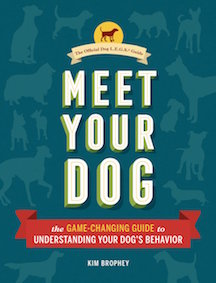 Little Companion
Little Companion
Bichon Frise, Bolognese, Cavalier King Charles Spaniel, Chihuahua, Chinese Crested, Coton De Tulear, Havanese, Japanese Chin, Lhasa Apso, Maltese, Papillon, Pekingese, Pomeranian, Pug, Shih Tzu, Tibetan Spaniel, Toy Poodle, mixes of any of the above breeds.
Working Wingman
Australian Cattle Dog (Blue Heeler), Australian Kelpie, Australian Shepherd, Bearded Collie, Beauceron, Belgian Groenendael, Belgian Malinois, Belgian Sheepdog, Belgian Tervuren, Berger Picard, Border Collie, Briard, Cardigan Welsh Corgi, German Shepherd, Old English Sheepdog, Pembroke Welsh Corgi, Polish Lowland Sheepdog, Puli, Pumi, Pyrenean Sheepdog, Shetland Sheepdog, Standard Collie, Swedish Vallhund, mixes of any of the above breeds.
With revolutionary tips for specific dog breeds, this book will change the life of every dog owner and lead to happier human-canine relationships.
Visit Website
The New Fear Free Guide
Dr. Marty Becker, From Fearful to Stress Free
 The biggest thing to recently happen to animal welfare is arguably the Fear Free Movement. Starting with veterinarians, changes were made to make vet visits a better experience for the pet and everyone involved. Then Fear Free moved into the household by creating the Fear Free Happy Homes program. Now, with the help of Fear Free father and renown author, Dr. Marty Becker talks about the new Fear Free book, From Fearful to Fear Free. Listen to Dr. Becker in the Fear Free Expert Series on Animal Radio.
The biggest thing to recently happen to animal welfare is arguably the Fear Free Movement. Starting with veterinarians, changes were made to make vet visits a better experience for the pet and everyone involved. Then Fear Free moved into the household by creating the Fear Free Happy Homes program. Now, with the help of Fear Free father and renown author, Dr. Marty Becker talks about the new Fear Free book, From Fearful to Fear Free. Listen to Dr. Becker in the Fear Free Expert Series on Animal Radio.
There are many things that might stress your animals out, some that you don't even know about. Take for instance LED lights that you've placed all throughout your house. They are actually flashing lights, which dogs can see, but we can't. Can you imagine what it's like to see a flashing light all the time? Our animals may also be able to hear the noises that our household machines make. Then there's separation anxiety. You know how it is when you leave your house and your dog starts whining and then you come back and you find all the destruction that it's done while you were gone? You might feel sorry for them and go over to them when you return and you hug them and love them, but that really actually creates more problems. By doing this, you are actually telling them that it's okay to be that way. These can all stress them out.
Our animals might be under a lot of stress, but the most important thing is what this stress can do to their health. Besides driving them crazy, it could also drive them to be sick. That's why Animal Radio is so behind the Fear Free program. It's a program that started in veterinary offices and now has extended to trainers and into homes. Do you have a Fear Free Happy Home? You should! There is now a guide for that, which was written by five great people that know the industry, that know about animals and the Ring Master is Dr. Marty Becker. He's really the father behind the Fear Free Movement.
Dr. Becker tells us about a new little dog that he adopted. His new dog is a distemper survivor. Unfortunately these dogs have a greater chance to have neurologic problems. He used to think it was endearing when his loyal little shadow followed him everywhere. This dog would even wait by the door for about an hour after he left the house. It actually became pathologic to where it actually affected his dog's health. The dog got so depressed when he travelled, that he had to put him on what he calls chill pills.
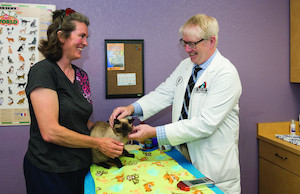 Before his "awakening," he spoke with Karen Overall, a Board Behaviorist; about what this fear was doing to our animals, and that literally a hundred percent of dogs have some level of fear, anxiety and stress.
Before his "awakening," he spoke with Karen Overall, a Board Behaviorist; about what this fear was doing to our animals, and that literally a hundred percent of dogs have some level of fear, anxiety and stress.
In the past, when Dr. Becker did his examinations on cats, he felt like he was stretching them out to where their head was in Idaho where he practices and their other half was in Montana, the next state over. He would also have to hold a dog down to get a blood sample. He tells us this one time where a dog actually pooped in his pocket. He felt it was a little warm down there and he reached in there and there was a dog turd in his pocket. He says he literally scared the poop right out of this poor little dog.
Besides starting the Fear Free Movement, Dr. Becker has come out with a new book, " From Fearful to Fear Free." It's a comprehensive guide to the Fear Free Movement and how to make your home fear free.
He has sold over 8,000,000 copies and written twenty-five books, with one of those books being Chicken Soup For The Pet Lovers. This book helped people realize there are other people out there that felt just like they did with regard to their pets. Other books he has written are, "Your Dog, The Owner's Manual" and "Your Cat, The Owner's Manual." These books are great for somebody starting out with a new pet, but literally there's a hundred books like this that he has on his bookshelf and that a lot of people have many pet books on their shelves as well. He tells us that there's probably a hundred books that are just as good for starting out with a new, a new dog or cat, but this is the first book that's ever been done on the emotional well-being of dogs.
Dr. Becker says this is a unique thing because he's a well-known veterinarian that started this movement and is a representative of the 220 some individuals behind it, and that two boarded veterinary behaviorist are also co-authors on this new book, along with a well-known trainer. Most people don't even know there is such a thing as a boarded veterinary behaviorist. There are 75 American College of Veterinary Behaviorist that are certified. Fifty-nine of them are part of the Fear Free Advisory Group. Dr. Becker tells us he hitchhiked on their education, their training and their experience.
Television has changed, because when he first started doing Good Morning America 22 years ago, the segments were eight minutes long and then they went to six and then to five and then to three and then to two. Funny thing with books, they've changed too and he has had to change with it. He informs us the book is really well done because it's like bite size. There are pictures, there are stories and you can read a few pages and get some ideas and not feel like, okay, here's another page and another page and another page. It's done for kind of a modern reader.
A lot of traveling is involved in his career and he tells us about when he was going to the International Association Animal Behavior Consultants Meeting; right after his new book came out. He was at the airport with a lot of trainers and there was a baby crying as it got on the plane. He noticed everybody turn, himself included, because it wasn't hysterically crying like spoiled crying, it seemed the baby was just upset. Everyone was looking and was forming their own opinions of thinking maybe the baby was hungry, had gas, was tired or had a dirty diaper. You go through the things you always know and everybody feels empathy. Can you imagine nobody caring when a baby cries and just thinking who cares, suffer away little baby and cry your eyes out!
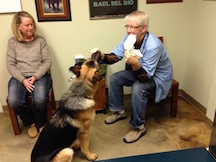 We always want to solve it and the point Dr. Becker is trying to make, is that pets are the same way. They don't cry like a baby, but they can show vocalization, there can be a change in eating habits, there can be a change in activity or bathroom habits or just a change in body language. We just need to know the signs. That's the first thing. If you got a dog that is shaking, panting, lip licking, yawning, drooling, trying to hide, those are pretty obvious. The more subtle signs are ones that avert their eyes, they wrinkle their forehead, they pin their ears back, they fidget and they show the whites of their eyes.
We always want to solve it and the point Dr. Becker is trying to make, is that pets are the same way. They don't cry like a baby, but they can show vocalization, there can be a change in eating habits, there can be a change in activity or bathroom habits or just a change in body language. We just need to know the signs. That's the first thing. If you got a dog that is shaking, panting, lip licking, yawning, drooling, trying to hide, those are pretty obvious. The more subtle signs are ones that avert their eyes, they wrinkle their forehead, they pin their ears back, they fidget and they show the whites of their eyes.
One of these things that got him when he was practicing medicine, was that he always thought dogs that went into the exam room and laid down and closed their eyes like they were going to sleep we're calm and that that was the best it could be, when actually it's the worst it can be. They actually have what's called collapsing immobility. So there's something called the defense cascade and the first thing is alert. Like if we were to hear a gunshot or scream or if a dog heard another dog in distress or maybe heard something it becomes fight or flight. So alert, fight or flight, and when it gets down to the end it is collapsing immobility. Three examples of this is one, you are in World War II, there's a trench of dead bodies and you're standing there with a firing squad. Why don't you run? It's because you're in collapsing immobility and you can't move. Two, you're in Syria, you're in an orange jumpsuit and you hear Jihadi John behind you and a film crew, why don't you run? And third, people that have had been assaulted, raped or other kinds of assaults, why don't they run? Their body just gives up. So a cat that's frozen or a dog that goes in and lies down with their eyes closed, that's as bad as it can possibly be.
What was the most important thing he learned in writing, "From Fearful to Fear Free?" He informs us the most important thing he learned would be that every pet has some degree of fear, anxiety and stress and that we need to take the time to parse out the triggers. For example, if you have a dog that's freaked out by thunderstorms, it's not okay for it to think it's going to die every time there's a thunderstorm. There are solutions, there are some training solutions, there are some more natural products, what he calls chill pills, there are some FDA approved products and the veterinary community has an obligation to tell pet owners about these.
Dr. Becker explains that now when he sees a pet he always asks if there are any pets at home that have behavior issues that the person would like to improve upon. He tells us that when you go back to these pets, fear is caused by something painful or something disturbing. So when a dog comes in a veterinary hospital, let's say it's been mauled by another dog, it got hit by a car, it ran through the woods and scratched it's eye, it's ear is a fire-pit, it's gums are inflamed, it's got severe arthritis, these all cause fear just by pain.
You need to think of the similarities of a dog and a one-year-old child. You can't explain anything to them. If you go to the doctor with them you can't tell them we're taking a blood sample, we're going to test their kidneys or they need tubes in her ears and it will hurt. You just can't explain to them why the procedure benefits them. The same thing with pain. They can't anticipate or expect the relief of pain even if it's moments away. And so for that reason, we're not going to manhandle a child and have six people hold a toddler down to do a procedure. It's the same thing with animals.
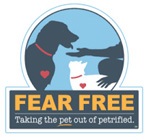 For 62 of his 64 years, and until writing this book, Dr. Becker states he has not petted a dog the correct way. Every time he'd see a dog on the street in New York or in his hometown of Bonners Ferry, Idaho or the veterinary clinic or wherever he was, he would start gushing telling the person that their dog was gorgeous or ask what their name was. He'd then put out his hand and let the dog sniff it. He would usually then pet the top of their head. These are all the wrong movements. Dogs don't see very well up. They see laterally to the side and down, but not very well up. By petting them on their head, Dr. Becker was coming from a blind spot, was reaching with his hand and had direct eye contact, all wrong. He tells us these dogs have smelled us before we even see them. They don't need to smell your hand. The proper way to pet a dog is by turning sideways, averting your gaze and crouching down if you can. You should then let them approach you. He tells us who would have thought that the simplest of things were actually causing fear, anxiety and stress when you're trying to be somebody doing good. If you think about it, this really makes sense.
For 62 of his 64 years, and until writing this book, Dr. Becker states he has not petted a dog the correct way. Every time he'd see a dog on the street in New York or in his hometown of Bonners Ferry, Idaho or the veterinary clinic or wherever he was, he would start gushing telling the person that their dog was gorgeous or ask what their name was. He'd then put out his hand and let the dog sniff it. He would usually then pet the top of their head. These are all the wrong movements. Dogs don't see very well up. They see laterally to the side and down, but not very well up. By petting them on their head, Dr. Becker was coming from a blind spot, was reaching with his hand and had direct eye contact, all wrong. He tells us these dogs have smelled us before we even see them. They don't need to smell your hand. The proper way to pet a dog is by turning sideways, averting your gaze and crouching down if you can. You should then let them approach you. He tells us who would have thought that the simplest of things were actually causing fear, anxiety and stress when you're trying to be somebody doing good. If you think about it, this really makes sense.
If you get one book this decade, and of course we live in an age where you know books are far and few between now because it's all digital (by the way, this book is also available as a kindle book) make it "From Fearful to Fear Free." This book will help you get along with your animal and it has the power to change their life and your life. Dr. Becker tells us that he's never been part of something that he felt stronger about than the emotional well-being of animals.
Visit Fear Free Happy Homes for tips on making your home fear free and to locate a Fear Free Veterinarian near you. Go to Fear Free Pets to become certified.
Listen and Explore the Fear Free Expert Series
Encountering The World's Deadliest Animals
Peter Gros, Mutual of Omaha's Wild Kingdom
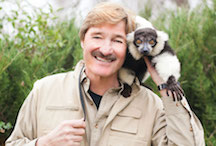 The little known insurance company, Mutual of Omaha, would've sunk into obscurity if it weren't for the marriage to the iconic television programming it hitched its name to. Marlin Perkins and his monkey hosted the Sunday evening tradition. The show lives on today as a web series hosted by this week's Animal Radio guest, Peter Gros. Peter talks about several harrowing experiences filming wild animals, including chasing a 12-foot python through the Waldorf-Astoria Hotel in Manhattan.
The little known insurance company, Mutual of Omaha, would've sunk into obscurity if it weren't for the marriage to the iconic television programming it hitched its name to. Marlin Perkins and his monkey hosted the Sunday evening tradition. The show lives on today as a web series hosted by this week's Animal Radio guest, Peter Gros. Peter talks about several harrowing experiences filming wild animals, including chasing a 12-foot python through the Waldorf-Astoria Hotel in Manhattan.
As you can imagine, this job has many stories behind it. One such story was when Peter had to chase a 12-foot python through, no, not the jungle, but the Waldorf-Astoria hotel in Manhattan. Peter explains that he was in his room at the hotel with the python because they we're going to be on what was called the Regis and Kathie Lee Show. When pythons are that large and they're about to shed, their eyes turn blue and they really can't see them much because they're going to shed all the skin off. So he put the python in a nice lukewarm bathtub of water where it would accelerate the shedding and the python would be very comfortable. Peter couldn't leave the room, so he ordered some room service. He got distracted and was busy on the phone and opened the door and the attendant came in and he told them to just put the food on the bed and he signed for the food. Well, you know how sometimes the latch on hotel doors will sort of come open? So between the door and this poor young gentleman who brought my food up was this python laying there looking at him. The python had come out of the tub and was gleaming and soaking wet. The poor man ran out of there and hit the elevator down the hall. Within 10 minutes Peter had a call saying, "Mr. Gros, this hotel does not allow pets!"
Picture, this, it's after midnight and Peter is trying to get a new room in Manhattan with six animals. These animals were going to be on national television while he talked about wildlife conservation and education. Peter wanted people to sort of connect with them, see them up close and become concerned about them. Fortunately the concierge at the Waldorf-Astoria was nice enough to shop around and find another hotel that took pets. It was a much older hotel, but Peter was happy to have any place to stay. Unfortunately he states that the new place came with its own pets and he had a sleepless night.
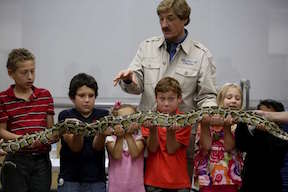 Growing up, Peter tells us he watched Mutual of Omaha's Wild Kingdom with Marlin Perkins and Jim Fowler. In fact, it was the only Sunday afternoon half hour show that he was allowed to watch. It amazed him that Marlin and Jim were out there in these countries, filming in these remote places and he was sitting there watching from his living room.
Growing up, Peter tells us he watched Mutual of Omaha's Wild Kingdom with Marlin Perkins and Jim Fowler. In fact, it was the only Sunday afternoon half hour show that he was allowed to watch. It amazed him that Marlin and Jim were out there in these countries, filming in these remote places and he was sitting there watching from his living room.
At the time, Peter had no idea he would get involved with the show. He became involved with the show later on in life after going to school, learning about animal husbandry and training. Before that, he had a lot to do with designing free-roaming animals displays, which was really what he enjoyed to do the most. He tells us he would turn the animals loose on islands and sort of cage people in these 30-person, Colorado River rafts, which he always got a kick out of the animals roaming free and watching the people going by and cages.
So what would Peter say is the most harrowing experience he's had with an animal, something that he didn't expect that maybe went wrong? Peter states that it usually wasn't the animals that were the problem, but the equipment. One time they were filming a Grizzly bear show in Alaska from a helicopter and they're these large Sitka spruce trees that were so close together that the helicopter couldn't land. So instead, they lower you down on a hundred-foot rope. You put your foot in a loop and you slide down. Just as he was stepping out on the skid, a gust wind hit it and blew him off into a tree. He was scratched up by a branch and had to be taken by a Medevac back to Fairbanks. He ended up with a few stitches in his face, which was quite an experience.
In terms of his most harrowing experiences with an animal, Peter tells us that when he was rafting the Zambezi River on the border of Zambia and Zimbabwe and they capsized several times in the class five waterfalls that are called Valley of the Giants. The local guys turned to him and casually said that he needed to get back in the boat much faster because this is where the crocodiles lay and wait for the food to come by. So he was a lot more attentive after that.
As you can image, it is virtually impossible for Peter to get any kind of medical or life insurance. In fact, he says they wanted to rate him the same as a crop duster (seems what he does is a lot more riskier than what a crop duster does!).
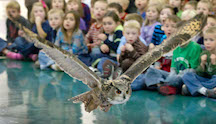 Peter has been fortunate to travel to most of the continents, but he would like to spend more time in the Amazon basin. He's gone down there a number of times and had even taken a group of 39 seventh graders down into the rain forest. He said he did the impossible and came back with all 39 seventh graders!
Peter has been fortunate to travel to most of the continents, but he would like to spend more time in the Amazon basin. He's gone down there a number of times and had even taken a group of 39 seventh graders down into the rain forest. He said he did the impossible and came back with all 39 seventh graders!
What Peter enjoys doing now is visiting universities, performing arts centers, schools and he seniors. He also enjoys giving corporate lecturers talking about his experiences throughout the world and the optimism that he's noticed with the progress we're making.
So does he still show animals? As a matter of fact, he says he is going to be in North Carolina in the next couple of days. Typically he will have someone come from a local zoo or have a zoo mobile of animals bring animals out where he is lecturing. He tells us that these are generally animals that have been rescued and had to be bottle-fed. They have become imprinted on people and they sort of think of people as their parents, so they're very comfortable around people. They have become wonderful ambassadors for their species. He also shows 80 to 90 minutes of clips that were filmed in the wild. This includes some of the bloopers that some that happened to you when you're filming in the wild that you didn't anticipate. He then invites young people up on the stage to meet maybe a hissing cockroach, a legless lizard, a huge python or the world's largest owl. These hand-raised animals are on stage and the youngsters can see them up close and personal. They also show a live camera feed on a huge screen so everybody can connect with wildlife.
Visit Their Web Series
Dogs Get The Flu Too - Canine Influenza - Dr. Debbie
 Can you give your dog the flu, or catch it from him? No way. But dogs can become infected with their own strain of canine influenza. With much attention on the tough human flu season, it's a good time to talk about the differences, and similarities, between human and canine influenza.
Can you give your dog the flu, or catch it from him? No way. But dogs can become infected with their own strain of canine influenza. With much attention on the tough human flu season, it's a good time to talk about the differences, and similarities, between human and canine influenza.
What is Dog Flu?
Canine Influenza, also known as H3N8, is a relatively new dog virus identified in 2004.The disease mutated from a strain of the equine influenza virus and was first detected in racing greyhounds. Canine influenza has migrated across the country and infections have been detected in 39 states, with heavy reports in recent years in New York, New Jersey, Florida and Colorado. However, some areas of the country have yet to report a single case of canine influenza.
Although the human flu peaks in winter seasons, canine influenza doesn't show seasonality; rather dogs can acquire canine influenza all year round.
The Illness
A dog sick with canine influenza develops respiratory infection signs similar to kennel cough that last three to four weeks. Symptoms include coughing, gagging, sneezing, runny nose and high fevers up to 104-106 degrees. Normal dog temperature ranges 101-102 degrees Fahrenheit.
Most dogs infected with canine influenza will get sick and recover. But like the human flu, fatalities can occur. Approximately 5-percent of canine influenza infected dogs may die, usually to secondary pneumonia. Older pets, pups, or those with chronic illness are more likely to develop pneumonia than the average healthy dog.
There isn't a specific treatment for dogs infected with canine influenza, but most dogs recover with supportive care including good nutrition, rest and maintaining adequate hydration. Severely ill pets with secondary bacterial pneumonia may be hospitalized and treated with IV fluids and antibiotics.
 Dog Flu Transmission
Dog Flu Transmission
Dog flu is similar to human flu in that it is spread by aerosol transmission as well as through contact with contaminated items. Since dogs don't cover their cough or sneezes, the virus is easily carried through respiratory droplets to other dogs and items in the immediate area. Any place that canines frequent, or spend time around, can become contaminated by infected dogs - that includes water bowls, surfaces and even human hands.
What do you do if you notice your dog's play pal is coughing, sneezing and has a runny nose? Separate your dog immediately and closely monitor your dog for symptoms for 7 days - the time it takes for symptoms to appear after exposure to the virus. If symptoms develop, call your veterinarian.
Pass that timeline and you are probably fine. But don't forget that 10 to 20-percent of infected dogs will shed the virus, but never show any symptoms of illness. These apparently healthy carriers can go on and spread the infection to other dogs without ever becoming ill.
Vaccination and Prevention Steps
A vaccine, produced by Merck, is available through veterinarians for canine influenza. But just like the human flu vaccine, it doesn't guarantee your dog CAN'T get sick. However the vaccine is helpful in decreasing the severity of infection and decreasing the spread of virus.
Vaccination for canine influenza isn't recommended for every dog at this time. Lifestyle and geographic location influence an individual dog's risk of acquiring canine influenza. Dogs that frequent high-density dog areas are at increased risk of canine influenza and are candidates for vaccination. So if your dog goes to areas like the dog park, trainer, groomer or boarding facility, ask your veterinarian if vaccination is a good idea.
Don't think you have to keep your dog locked in the house forever to hide from canine influenza. For most dogs, the risk of contracting canine influenza is quite small. Good sense and preventative steps are useful to avoid dog illness. These include quarantining new or sick dogs, using good hygiene through disinfection and hand washing and avoiding unnecessary contact with suspected infected dogs, especially if your dog is young, old, or has a compromised immune system.
What Should Pet Owners Do?
Flu awareness and preparedness makes good sense - for both people and pets. But remember that there are other causes of canine respiratory disease. So just because you hear a cough doesn't mean your dog has the flu. Ask your veterinarian about your pet's individualized risks for acquiring canine influenza.
Featured veterinarian known as "Dr. Debbie" on national pet radio program, Animal Radio. Ebook author of "Yorkshire Terriers: How to Be Your Dog's Best Friend"; "Pugs: How to Be Your Dog's Best Friend"; "Mini Schnauzers: How to Be Your Dog's Best Friend"; and "Shih Tzu: How to Be Your Dog's Best Friend." Dr. Debbie's books.
Visit Website
Animal Radio News - Lori Brooks
 Pet Obesity Still On The Rise
Pet Obesity Still On The Rise
Pet obesity in the U.S. increased last year, affecting 60-percent of cats and 56-percent of dogs, according to the Association for Pet Obesity Prevention tenth annual survey. Veterinarians involved with the survey say they are continuing to see more pets diagnosed with obesity rather than being simply overweight. Obesity in pets results in more secondary conditions such as arthritis, high blood pressure, kidney disease and certain forms of cancer. Pets with obesity also have reduced quality of life and shorter life expectancy. It's pretty much the same as with humans and obesity. When asked what was the biggest challenge to exercising dogs, "too busy" was the most common response, topping 25-percent of all pet owners. A close second was behavior issues. When asked if they believed commercial pet food is better or worse than ten years ago, 63-percent of pet owners and 76-percent of veterinary professionals thought pet food in 2017 had improved. Almost 70-percent of vets feed their dogs dry kibble, compared to 53-percent of the public. Cats were more evenly split; dry cat food was fed by 49-percent of the public and 57-percent of veterinary professionals. What about raw diets? Nearly half of pet owners and 15-percent of vets said they didn't know whether raw diets were healthier for dogs and cats. And only 21-percent of veterinary professionals felt a grain-free diet was healthier for dogs. A full 63-percent do not believe low- or no-grain diets are healthier for dogs.
 Hummingbird Love Charm Trade
Hummingbird Love Charm Trade
National Geographic recently ran a story on the black market trading of dead hummingbirds, called "Inside the Black Market Hummingbird Love Charm Trade." These black market traders catch a hummingbird, kill it, wrap it in underwear, cover it with honey and then sell it on the black market to people who will then make it into a Love Charm called a Choo-pa-rosas. The so-called "love charm" is supposed to arouse passion in lovers.
Airlines Make New Policies Regarding Emotional Support Animals
Airlines and their pet policies are back in the news with Alaska Airlines announcing it is making policy changes for passengers who fly with emotional support and psychiatric service animals. The airline will now require passengers traveling with those types of animals to provide animal health and behavioral documents that must be signed by a medical doctor or mental health professional. All of the forms must be submitted at least 48 hours before departure. At least 150 emotional support and psychiatric service animals travel on Alaska Airlines planes every day. A spokesperson for the airline says the changes are being made because of an increasing number of recent incidents where the inappropriate behavior of emotional support animals has impacted and even injured their employees, other service animals and passengers. Besides Alaska, both Delta and United Airlines both adopted similar requirements, which went into effect March 1. Of course, the policy changes do not apply to traditional service animals such as guide dogs for the blind.
 Firefighters Send Stoned Raccoon Home To Sleep It Off
Firefighters Send Stoned Raccoon Home To Sleep It Off
Firefighters at Wayne Township Station 82 in Indiana must still be laughing about a recent visit they had from a frantic woman who showed up at the station house early one morning with her pet raccoon. The raccoon was stoned after being exposed to too much marijuana and the owner thought the raccoon was overdosing. Later, they discovered the raccoon had actually gotten into someone's stash of heroine. They sent the raccoon home to sleep it off, hoping it would be okay.
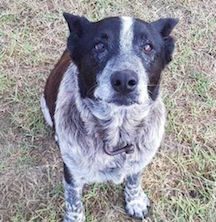 17-Year-Old Dog Stays With Lost Girl Until Rescued
17-Year-Old Dog Stays With Lost Girl Until Rescued
A deaf and partially blind dog has been bestowed with the new title of hero. Max is a 17-year-old Blue Heeler from Queensland, Australia, who is being praised after spending more than 15 hours overnight in rugged terrain, in the rain, with a lost three-year-old girl. By the next morning, more than 100 Emergency Service volunteers, police and others were searching for the little girl named Aurora. Later, following her disappearance, Aurora's grandmother, said she heard the little girl's voice from the top of the mountain and headed toward it, where she found Max the dog who led her to her granddaughter who was found more than a mile away from her home. Since that incident, Max was given the title of honorary police dog for his heroic act.
 Pet Friendly Work Places
Pet Friendly Work Places
Amazon is a huge company and more than 6,000 employees are registered to bring their dog to work with them. Amazon is so dog friendly that the reception desk keeps a bucket of dog treats and they have a dog park on the work campus. Other large companies that allow pets to go to work with their parents include Bank of America, Purina, Petco, and ice cream makers Ben & Jerry's.
 Listen to the entire Podcast of this show (#961)
Listen to the entire Podcast of this show (#961)





